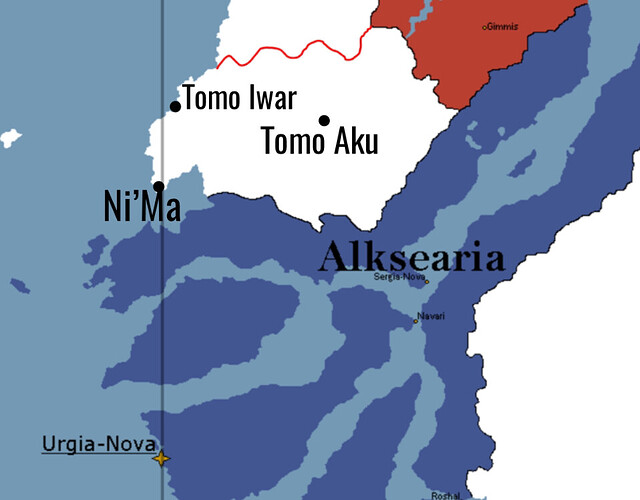Joint Claim with Cowlass
Claim; Tomo Aku is Capitol, Tomo Iwar is Metropolis, Ny’Ma is small city
Flag:
Nation Name (long): Akuan Republic of Ma Moku (Kulupu Jan Aku Ma Moku)
Nation Name (short): Ma Moku
WIKI: https://tep.wiki/wiki/Ma_Moku
Motto: Jan mi li anpa e ike ali (Our people conquer all evil)
National Animal: Tucan (Waso Kule)
National Flower/Plant: Kalama Les (Læs’ Trumpet)
National Anthem: Ma Pona Mi (Our Good Land)
Capitol: Tomo Aku
Largest City (Metropolis): Tomo Iwar
Demonym: Ma Moku
Language: Toki Pona (Official), Nys’tat’en (Religious)
Species:
64% Kelf
27% Kemonomimi
9% Elves
Population: 6,210,000 (2023)
Government type: Akuan Democratic Republic
Leader(s):
Shrinekeeper (Jan Awen Nasin): Malikawet Ni’Piletesen
Prime Minister (Jan Lawa Kulupu): Pijowinal Ni’Jansen
Legislature: Tomo Kulupu
Upper house: Kulupu Lili Ala
Lower house: Kulupu Jan
Formation: 1642
Total GDP: 65 Billion
GDP per capita: 10,466
Currency: Red Krone / Kiwona Loje (RKR)
Calling Code: +750
ISO 3166 code: MAM
Internet TLD: .mam
Historical Summary:
The ancient Jan Ma Moku - people of Ma Moku, or the Land of Food - were hunter-gatherers before they settled in the lands which would become Ma Moku. Elves of the Kaohlat subspecies, these settlers were enchanted by the beauty of the land in which they found themselves. Believing the abundance of Ma Moku to be sufficient for their needs, they settled and soon began farming, developing agriculture before their Banteay and Shamsian counterparts. Agricultural society made way to feudal society, and by the 12th century, a few city-states and small kingdoms had developed in the small, local farming communities of Ma Moku.
The Akuan settlers, primarily made up of Nya’Kin (Isler Boreans; Kemonomimi) ethnic group, arrived in these days, landing on the shores of Ma Moku and building their ports and shrines on land owned by these feudal lords. The low population of the Jan Ma Moku made war infeasible - each death cost the feudal states much, and the low coercive capacity of the weak, often decentralized kingdoms could not readily bring war upon the new settlers for fear of revolt. Instead, concessions were made for peace in Ma Moku, and strong trade networks were built. Though fishing was not uncommon in Ma Moku, the Akuanists brought to those lands faster and bigger ships. Moreover, they brought their religion. The decentralized spiritualism of Ma Moku was quickly replaced by the structured philosophy of Akuanism.
By the 1530 coronation of Jan Suli (King) Iwar Mama-li-Matijas of Ma Telo Suli en Kasi Pimeja (The Land of Big Lake and Dark Beasts), a small kingdom in the Ma Moku region, Akuanism had penetrated the cultural fabric of most Ma Moku communities. Ma Telo Suli en Kasi Pimeja was, however, far more religious than most. Iwar Mama-li-Matijas, a Kelf descendent of a Ma Moku King and a Nya’Kin merchant, soon sought to unify the land of Ma Moku, including the Jan Ma Moku and the Nya’Kin, under the banner of an Akuan nation-state. Earning the blessing of the Akuan brewmasters, Jan Suli Iwar brought unity to Ma Moku through peaceful negotiations and, on more than one occasion, the fabrication of a succession crisis and backing of a pro-unification leader.
Kulupu Aku Ma Moku, the Akuan Nation of Ma Moku, was founded in 1549, with Iwar Mama-li-Matijas serving as its Jan Suli Suli, or High King, while the disparate kingdoms of Ma Moku were maintained under a federal model with their own Jan Suli. Though power was officially shared with these local rulers, the national government’s taxes soon overtook those of the smaller kingdoms, and, by virtue of their position as the founder and hero of Ma Moku, Jan Suli Suli Iwar was increasingly popular amongst all the people of Ma Moku. By the end of their rule in 1563, Iwar Mama-li-Matijas had effectively replaced every local leader with devout Akuanists and friends of the Jan Suli Suli.
This power declined slightly with Iwar’s child and successor, Lalis Mama-li-Iwar. Jan Suli Suli Lalis, lacking their parent’s status as the holy prophet of the Ma Moku nation, lost much control over the constituent territories of Ma Moku. Systemically, Lalis had the same amount of control, but lost much love and power. Their own successor, Jilta Mama-li-Lalis, lost even more power, until the year 1641, when local rulers Kina Mama-li-Tawalit and Owijan Mama-li-Siwen launched a bloody revolt to break free from the High Kingdom. The Jan Suli Suli renamed themselves to Jilta Ni’Iwarisen in order to strengthen their connection to their grandparent, the great hero Iwar, and unify the two cultures of Ma Moku. Jilta met this revolt with brutal suppression by the military of Ma Moku, fueled by decades of centralized taxes and power over local armies. In a few short months, the civil war had ended, and the federation had dissolved to make way for a unitary state,
Claiming a divine vision from Aku, Jan Suli Suli Jilta gave up their crown in 1642, devolving power to a democracy in a newly formed Constitution, the Lipu Jan, which created Akuan Democracy in Ma Moku for the first time. With a bicameral legislature and an elected leadership position, but a strong central focus on Akuan values and beliefs, the new government took effect in the same year. Jilta Iwarisen, spurred by this divine vision, stayed in the capital city of Tomo Aku, which Iwar had built, and was elected as a Brewmaster, rather than pursuing politics.
Through the past few centuries, the Akuan Republic of Ma Moku has developed into an agrarian republic. Its membership in the RCEU and adoption of the Red Krone in 2023 paved the way for further international cooperation. Its modern government bears many similarities to its founding days, but modern politics continue to push Ma Moku towards more urbanization, industrialization, and globalization.

